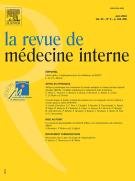Conduite à tenir devant une hypogammaglobulinémie - 31/01/23
Management of hypogammaglobulinemia
Cet article a été publié dans un numéro de la revue, cliquez ici pour y accéder
Résumé |
Une hypogammaglobulinémie (hypoγ) est définie par un taux sérique d’IgG < 7 g/L. Le plus souvent, elle est détectée sur une électrophorèse des protéines sériques. Étant donné l’existence d’hypoγ transitoire, il faut recontrôler à distance sa persistance, de préférence en demandant un dosage sanguin des IgG, IgA et IgM dont on aura besoin pour caractériser un éventuel déficit immunitaire primitif (DIP). En cas d’association avec un composant monoclonal, il faut rechercher une cryoglobuline à l’origine d’une fausse hypoγ. Sinon, l’enquête étiologique est dictée par l’examen clinique. Par exemple, la notion de diarrhée chronique doit conduire à rechercher une entéropathie à l’origine d’une perte digestive de gammaglobulines (situation ambiguë, car certains DIP peuvent se compliquer d’une entéropathie). En l’absence d’orientation évidente, il faut d’abord éliminer une cause secondaire (les déficits immunitaires secondaires sont 30 fois plus nombreux que les DIP). Le premier examen simple à réaliser est une protéinurie des 24h, couplée à une électrophorèse des protéines urinaires, permettant d’éliminer 2 diagnostics : un syndrome néphrotique et un myélome à chaînes légères. Par la suite, un immunophénotypage sanguin à la recherche d’un clone B circulant est recommandé, permettant d’orienter les recherches vers une hémopathie lymphoïde. Une hypoγ d’origine médicamenteuse sera également suspectée en cas de prise de certaines thérapeutiques telles que corticoïdes, antiépileptiques ou immunosuppresseurs (anti-CD20, notamment). Le profil d’une hypoγ médicamenteuse est différent de celui d’un DIP : elle est rarement profonde, le taux d’IgA est préservé et il n’y a pas de déficit en lymphocytes B mémoires commutés. Enfin, un scanner thoracoabdominal permettra d’éliminer un thymome et d’identifier un syndrome tumoral profond. En cas de normalité de ces examens, on parlera de DIP, dont le chef de file chez l’adulte reste le déficit immunitaire commun variable qui est le DIP symptomatique le plus fréquent chez l’adulte.
Le texte complet de cet article est disponible en PDF.Abstract |
Hypogammaglobulinemia (hypoγ) is defined as a serum IgG level < 7 g/L. It is most often detected on serum protein electrophoresis. Given the existence of transient hypoγ, its persistence should be checked at distance, preferably by requesting a blood test for IgG, IgA and IgM, which will be needed to characterize a possible primary immune deficiency (PID). In the case of association with a monoclonal component, the first step is to look for a cryoglobulin causing a false hypoγ. Otherwise, the etiological investigation is dictated by the clinical examination. For example, the notion of chronic diarrhea should lead to a search for an enteropathy causing a digestive loss of gammaglobulins (an ambiguous situation because some DIP can be complicated by an enteropathy). In the absence of an obvious explanation, a secondary cause must first be ruled out (secondary immune deficiencies are 30 times more common than PID). The first simple test to perform is 24-hour proteinuria, coupled with urinary protein electrophoresis, to rule out 2 diagnoses: nephrotic syndrome and light chain myeloma. Subsequently, blood immunophenotyping looking for a circulating B clone is recommended, allowing the investigations to be directed towards a lymphoid hemopathy. Drug-induced hypoγ may also be suspected if certain drugs such as corticosteroids, anti-epileptics or immunosuppressive agents (especially anti-CD20) are taken. The profile of a drug-induced hypoγ is different from that of a DIP: it is rarely profound, the IgA level is preserved and there is no deficit in switched memory B lymphocytes. Finally, a thoracoabdominal CT-scan will help to rule out a thymoma and identify a deep tumor syndrome. If all these tests are normal, a PID is suspected, the leader of which in adults remains the common variable immunodeficiency, which is the most frequent symptomatic PID in adults.
Le texte complet de cet article est disponible en PDF.Mots clés : Hypogammaglobulinémie secondaire, Hypogammaglobulinémie primitive, Déficit immunitaire commun variable
Keywords : Secondary hypogammaglobulinemia, Primary hypogammaglobulinemia, Common variable immunodeficiency
Plan
Bienvenue sur EM-consulte, la référence des professionnels de santé.
L’accès au texte intégral de cet article nécessite un abonnement.
Déjà abonné à cette revue ?


